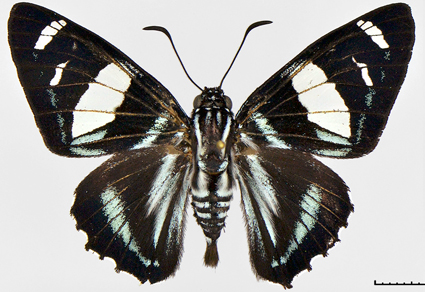Abstract
Genomic sequencing and analysis of holotypes from the MIZA collection (Maracay, Venezuela) and their comparison with other species and their type specimens advances our understanding of their taxonomy. Jemadia demarmelsi Orellana, [2010] is confirmed as a species-level taxon and its female is genetically verified. The following are species-level taxa, not subspecies: Amenis pedro O. Mielke & Casagrande, 2022, stat. nov. (not Amenis pionia (Hewitson, 1857)) and Jemasonia sosia (Mabille, 1878), stat. rest. (not Jemasonia hewitsonii (Mabille, 1878)). Amenis ponina rogeri Orellana, [2010], stat. nov. and Jemasonia pater ortizi (Orellana, [2010]), stat. nov. are subspecies, not species. Jemadia pseudognetus imitator (Mabille, 1891), comb. nov. (not Jemadia hospita (Butler, 1877)) and Damas cervelina Orellana & Costa, 2019, comb. nov. (not Megaleas Godman, 1901) are new combinations.
References
- Cong, Q., Shen, J., Zhang, J., Li, W., Kinch, L.N., Calhoun, J.V., Warren, A.D. & Grishin, N.V. (2021) Genomics reveals the origins of historical specimens. Molecular Biology and Evolution, 38, 2166–2176. https://doi.org/10.1093/molbev/msab013
- Cong, Q., Zhang, J. & Grishin, N.V. (2019a) Genomic determinants of speciation. bioRxiv, BIORXIV/2019/837666. [published online] https://doi.org/10.1101/837666
- Cong, Q., Zhang, J., Shen, J., Cao, X., Brevignon, C. & Grishin, N.V. (2020) Speciation in North American Junonia from a genomic perspective. Systematic Entomology, 45, 803–837. https://doi.org/10.1111/syen.12428
- Cong, Q., Zhang, J., Shen, J. & Grishin, N.V. (2019b) Fifty new genera of Hesperiidae (Lepidoptera). Insecta Mundi, 0731, 1–56.
- Evans, W.H. (1951) A catalogue of the American Hesperiidae indicating the classification and nomenclature adopted in the British Museum (Natural History). Part I. Introduction and Group A Pyrrhopyginae. The Trustees of the British Museum (Natural History), London, x + 92 pp., 9 pls.
- Grishin, N.V., Burns, J.M., Brockmann, E., Hallwachs, W. & Janzen, D.H. (2014) A cryptic new Jemadia (Hesperiidae: Pyrginae: Pyrrhopygini) from Costa Rica and Panama with a subtly distinctive combination of blue rays and white bands. The Journal of the Lepidopterists’ Society, 68, 232–247. https://doi.org/10.18473/lepi.v68i4.a2
- Hebert, P.D., Cywinska, A., Ball, S.L. & deWaard, J.R. (2003) Biological identifications through DNA barcodes. Proceedings of the Royal Society B: Biological Sciences, 270, 313–321. https://doi.org/10.1098/rspb.2002.2218
- ICZN [International Commission on Zoological Nomenclature] (1999) International code of zoological nomenclature. 4th Edition. International Trust for Zoological Nomenclature, London, xxx + 306 pp.
- Li, W., Cong, Q., Shen, J., Zhang, J., Hallwachs, W., Janzen, D.H. & Grishin, N.V. (2019) Genomes of skipper butterflies reveal extensive convergence of wing patterns. Proceedings of the National Academy of Sciences of the United States of America, 116, 6232–6237. https://doi.org/10.1073/pnas.1821304116
- Lukhtanov, V.A., Sourakov, A. & Zakharov, E. (2016) DNA barcodes as a tool in biodiversity research: testing pre-existing taxonomic hypotheses in Delphic Apollo butterflies (Lepidoptera, Papilionidae). Systematics and Biodiversity, 14, 599–613. https://doi.org/10.1080/14772000.2016.1203371
- Mielke, O.H.H., Brockmann, E. & Mielke, C.G.C. (2022) Hesperiidae II, New World Pyrrhopyginae, detailed text. Verlag Goecke & Evers, Keltern, 120 pp.
- Orellana, A.M. ([2010]) Pyrrhopyginae de Venezuela (Lepidoptera: Hesperioidea: Hesperiidae). Entomotropica, 23, 177–291.
- Robbins, R.K., Cong, Q., Zhang, J., Shen, J., Busby, R.C., Faynel, C., Duarte, M., Martins, A.R.P., Prieto, C., Lamas, G. & Grishin, N.V. (2022) Genomics-based higher classification of the species-rich hairstreaks (Lepidoptera: Lycaenidae: Eumaeini). Systematic Entomology, 47, 445–469. https://doi.org/10.1111/syen.12541
- Zhang, J., Cong, Q., Shen, J., Brockmann, E. & Grishin, N.V. (2019a) Genomes reveal drastic and recurrent phenotypic divergence in firetip skipper butterflies (Hesperiidae: Pyrrhopyginae). Proceedings of the Royal Society B: Biological Sciences, 286, 20190609. https://doi.org/10.1098/rspb.2019.0609
- Zhang, J., Cong, Q., Shen, J. & Grishin, N.V. (2022a) Taxonomic changes suggested by the genomic analysis of Hesperiidae (Lepidoptera). Insecta Mundi, 0921, 1–135.
- Zhang, J., Cong, Q., Shen, J., Opler, P.A. & Grishin, N.V. (2019b) Changes to North American butterfly names. The Taxonomic Report of the International Lepidoptera Survey, 8, 1–11.
- Zhang, J., Cong, Q., Shen, J., Opler, P.A. & Grishin, N.V. (2019c) Genomics of a complete butterfly continent. bioRxiv, BIORXIV/2019/829887. [published online] https://doi.org/10.1101/829887
- Zhang, J., Cong, Q., Shen, J., Opler, P.A. & Grishin, N.V. (2020) Genomic evidence suggests further changes of butterfly names. The Taxonomic Report of the International Lepidoptera Survey, 8, 1–40.
- Zhang, J., Cong, Q., Shen, J., Opler, P.A. & Grishin, N.V. (2021) Genomics-guided refinement of butterfly taxonomy. The Taxonomic Report of the International Lepidoptera Survey, 9, 1–54.
- Zhang, J., Cong, Q., Shen, J., Song, L., Gott, R., J., Boyer, P., Guppy, C.S., Kohler, S., Lamas, G., Opler, P.A. & Grishin, N.V. (2022b) Taxonomic discoveries enabled by genomic analysis of butterflies. The Taxonomic Report of the International Lepidoptera Survey, 10, 1–59.
- Zhang, J., Cong, Q., Shen, J., Song, L. & Grishin, N.V. (2022c) Genomic DNA sequencing reveals two new North American species of Staphylus (Hesperiidae: Pyrginae: Carcharodini). The Taxonomic Report of the International Lepidoptera Survey, 10, 1–13.
- Zhang, J., Shen, J., Cong, Q. & Grishin, N.V. (2019d) Genomic analysis of the tribe Emesidini (Lepidoptera: Riodinidae). Zootaxa, 4668 (4), 475–488. https://doi.org/10.11646/zootaxa.4668.4.2

